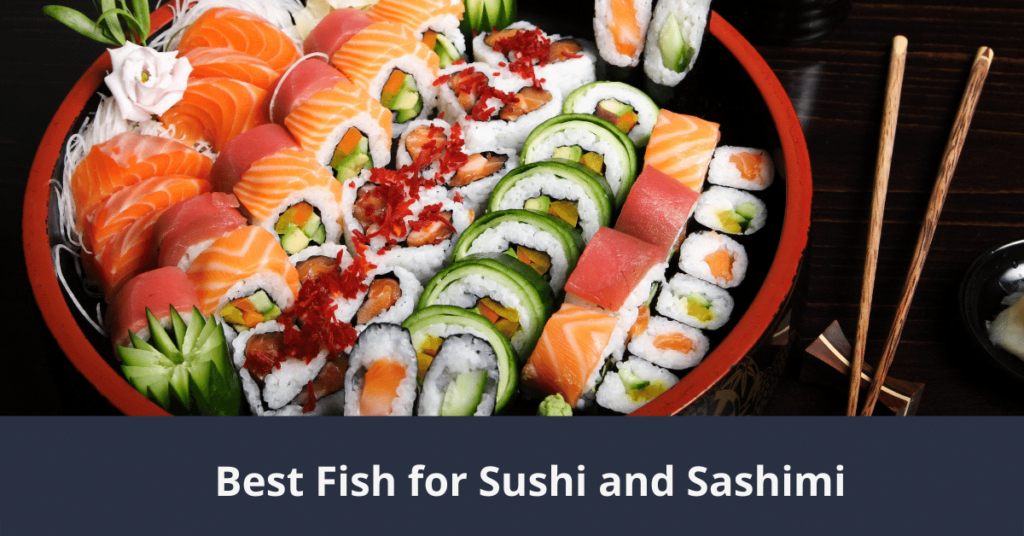The key to making the best sushi or sashimi at home is knowing what kinds of fish to use. While it goes without saying that you want to use the freshest and most high-quality fish cuts possible, making sushi or sashimi is an art that has been refined over several centuries.
If you’re ready to try making this distinctive cuisine at home, read on for insights into the best fish for sushi and sashimi.
Everything you will learn here
Our Roundup of the Ten Best Fish for Sushi And Sashimi
Let’s jump right in and start talking about the ten best fish to use if you want to make sushi and sashimi home.
1. Saba
“Saba” is the Japanese term for the Pacific mackerel. Besides being loaded with protein, this fish is also high in vitamins, minerals, and omega-3 fatty acids. When it appears on the menu of many American sushi joints, many diners do not enjoy its strong, extremely fishy smell.
The truth is that even when it’s uncooked, saba has an intense, oily flavor that won’t get drowned out by other spicy ingredients or condiments such as wasabi, soy sauce, ginger, or scallions.
You can prepare saba in any number of ways. In Japan, they often can and sell it alongside tuna. When canned, the bones become gelatinous, and you can eat it straight from the can. In Japan, saba is a staple used not just in sushi or sashimi but also in several soups and curries.
2. Uni
“Uni” is the Japanese word for sea urchin. Although various sea urchins species can be found in oceans worldwide, they are difficult to catch in the wild.
Within the body of a sea urchin, there are five distinct “tongues,” ranging in color from yellow to orange and consistent with banana pudding. When you order uni in a restaurant, you’re eating one of these tongues.
Uni is considered a delicacy in Japan, where it is often harvested by hand by specially-trained divers. Uni has a thick, creamy, rich flavor that is also briny and reminiscent of the sea.
While uni isn’t terribly difficult to prepare as sushi, it can be expensive and somewhat difficult to obtain depending on where you live. You typically won’t find it at regular grocery stores, so you’ll need to find a seafood wholesaler or an Asian grocer.
3. Kampachi
“Kampachi” is the Japanese word for yellowtail. Although you can still obtain wild yellowtail, the majority of the fish sold in the market come from fish farms around the world. Farmed kampachi has an extremely high-fat content, with negligible mercury levels and far fewer parasites than other fish.
The other notable advantage to farmed kampachi is that the farm-raised variety also contains no GMO’s and antibiotics. If you do end up purchasing farmed kampachi, confirm that they sustainably raised your fish.
While it’s a staple in many sushi restaurants, yellowtail has exploded in popularity over the last few years because it’s also a sought-after ingredient in ceviche and many other cuisines.
Whether you end up preparing sushi with wild-caught or farmed kampachi, it’s extremely high-fat content gives it a subtle, rich flavor, even with no spices or condiments.
4. Iwashi
“Iwashi” is the Japanese word for sardine. In the present day, Iwashi has become a popular variety of fish at many sushi restaurants, but it wasn’t always this way. Traditionally, iwashi was never served with sushi or sashimi because it would spoil very quickly. Because of its quick spoilage, iwashi was often served cooked or grilled.
This method changed after World War II, when many Japanese restaurants finally gained access to commercial refrigeration, making it safe and feasible to start serving Iwashi as sushi or as nigiri.
However, iwashi will still spoil quickly, so chefs rarely serve it fresh. Instead, they salt iwashi and then preserve it in rice vinegar in such a way that it emerges with a distinct sweet and sour taste. This is another oily, super-rich type of fish that doesn’t need much embellishment.
5. Engawa
“Engawa” is the Japanese word for halibut. When prepared as sushi or sashimi, engawa is a soft, dense, white fish cut from the area near the muscular tail fin. Because of this, servings of engawa in sushi restaurants will typically yield only three or four pieces of meat.
While the term “engawa” technically refers to halibut, you’ll also find it sold in American sushi restaurants as flounder or fluke. Unlike most other cuts of fish used in sushi or sashimi, engawa is mature muscle meat taken from around the fin, which gives it an extremely savory, intense flavor.
Engawa is naturally crunchy and chewy, with high protein, oil, and omega-3 fatty acids that help reduce depression and lower cholesterol. They’ve also been proven to help prevent cancer and diabetes.
Genuine cuts of engawa are costly and highly sought after among sushi enthusiasts. If you’re dead set on getting some for your sushi dinner, you’ll need to call a seafood wholesaler or an Asian grocer.
6. Ika
“Ika” is the Japanese word for squid. In American culture, squid is an out-of-left-field dish that many people refuse to eat. This is a real shame because squid is a dish with a complex and subtle flavor.
In Japanese culture, cephalopods such as octopus or squid are considered to have such distinctive tastes that they’ve been given their own category of flavor, “umami,” which denotes a dish a distinct savory and meaty taste. Preparing squid as sushi or sashimi is a bit of a challenge because even its freshest squid is rubbery and difficult to cut and serve without specialized training properly.
The other challenge with preparing squid in sushi dishes is that while it tastes wonderful, it can be difficult for novice cooks to prepare properly. Its rubbery texture means it won’t sit easily on rice like other fish cuts.
If you live on the west coast, finding squid or octopus isn’t terribly difficult. However, if you live elsewhere in the United States, finding squid will require a trip to a seafood wholesaler.
(You might also be interested in reading about the Most Expensive Sushi Fish)
7. Tako
Tako is the Japanese word for octopus, which is a staple of Japanese cuisine. When the octopus is prepared as sushi or sashimi, it is typically cut into thin pieces in the julienne style. Whether you serve the octopus raw or cooked, it has a sweet and delicate flavor when prepared properly.
Although it’s a bit rarer and thus more difficult to find in certain parts of the United States, octopus adds an unexpected and exotic twist to any meal when prepared properly. It might taste a little strange if you’ve never had it before, but the octopus is an excellent source of omega-3 fatty acids and vitamin B12.
8. Ahi Tuna
There are two primary varieties of ahi tuna: bigeye and yellowtail. Big eye tuna is fatty, with a rich and buttery flavor. Like Iwashi or Kampuchi, Bigeye tuna is naturally flavorful and doesn’t require much in spices or condiments. Yellowtail tuna is leaner and firmer but also naturally flavorful.
Professional sushi chefs have been using ahi tuna for hundreds of years, but ahi tuna has only become popular outside of Japan in the last decade. Ahi tuna is a popular ingredient in sushi, but it has also become a popular ingredient in burgers and tacos.
9. Salmon
Referred to in Japanese as sake, salmon is a popular fish the world over, so it’s no surprise that it’s a common ingredient in sushi and sashimi. It might be somewhat more common than a lot of the other fish on our list, but with its rich flavor and distinctive pink color, it’s a tasty and visually appealing companion to rice.
Many people find that salmon is equally tasty when used in sushi, whether they serve it raw or cooked. The health benefits of salmon are almost too numerous to mention. It’s a rich source of selenium, potassium, B vitamins, and omega-3 fatty acids.
10. Albacore Tuna
A close relative of the bluefin tuna, the albacore tuna is a delicate cut of fish that is a highly sought-after ingredient for sushi. It has a surprisingly smooth texture because it is native to the world’s oceans’ warmer, tropical regions.
When sushi chefs albacore tuna in sushi, they use what is known as the tataki method, where they slightly grill the outside and then submerge it briefly in ice water. This cooking process serves to amplify this fish’s rich, distinctive taste.
We also have some other related articles specially for fish eaters:
Conclusion
We hope this little roundup article helped give you some idea of the kinds of fish that work best for sushi and sashimi.
Take the time to ask your butcher or wholesaler where their fish comes from and what procedures they use to store it in a safe and sanitary fashion. If you end up buying farmed fish, make sure the fish were raised and nurtured sustainably on a diet free of antibiotics and steroids.
And, of course, enjoy your delicious sushi or sashimi dish!




